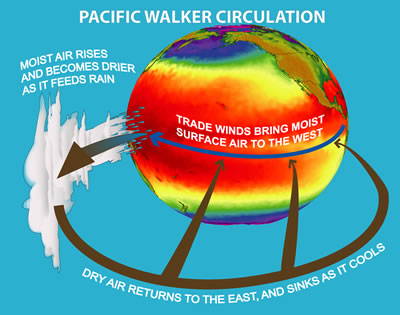This is a three-dimensional view of the Walker circulation. The Walker circulation consists of trade winds blowing from east to west across the tropical Pacific Ocean (blue arrow), bringing moist surface air to the west. In the western tropical Pacific, the moist air rises, forming clouds. The rising air becomes drier as much of its moisture falls to the surface as rain. Winds a few miles high blow from west to east, moving the now drier air toward South America. The air returns back to the surface in the eastern tropical Pacific, dry and relatively cloud free, completing the circulation loop.
Click on image for full size
Image courtesy of NOAA Geophysical Fluid Dynamics Laboratory
Walker Circulation
The Walker circulation is an ocean-based system of air circulation that influences weather on the Earth. The Walker circulation is the result of a difference in surface pressure and temperature over the western and eastern tropical Pacific Ocean. Normally, the tropical western Pacific is warm and wet with a low pressure system, and the cool and dry eastern Pacific lie under a high pressure system. This creates a pressure gradient from east to west and causes surface air to move east to west, from high pressure in the eastern Pacific to low pressure in the western Pacific. Higher up in the atmosphere, west-to-east winds complete the circulation.
The warm waters of the western Pacific Ocean in East Asia heat the air above it and supply it with moisture. On average, the air rises, forms clouds, and then flows to the east across the Pacific, losing moisture to rainfall. The air then sinks off the west coast of South America and returns to the west along the surface of the ocean, back to the western Pacific Ocean.
The Walker circulation contributes to normal weather conditions in the tropical Pacific Ocean: warm, wet weather in the western Pacific and cool, dry weather in the eastern Pacific.
The Walker circulation reverses every few years, as part of a phenomenon called the El Niño-Southern Oscillation (ENSO). When the Walker circulation weakens, the winds also weaken and the warm water of the western Pacific spreads to the east. These conditions are called El Niño. During times when the Walker circulation is particularly strong, called La Niña, the winds are stronger across the Pacific. These strong winds cause cooler ocean temperatures because of upwelling in the eastern Pacific. El Niño and La Niña impact the weather in North and South America, Australia, and Southeast Africa, and can cause flooding, droughts, and increases or decreases in hurricane activity.
You might also be interested in:

Wind is moving air. Warm air rises, and cool air comes in to take its place. This movement creates different pressures in the atmosphere which creates the winds around the globe. Since the Earth spins,
...more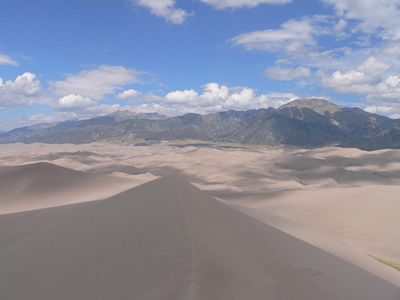
A cloud is composed of tiny water droplets or ice crystals that are suspended in the air. A series of processes have to happen in order for these water droplets or ice crystals to form into clouds in the
...more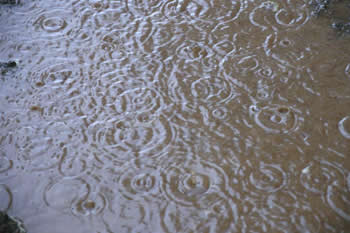
Rain is precipitation that falls to the Earth in drops of 5mm or more in diameter according to the US National Weather Service. Virga is rain that evaporates before reaching the ground. Raindrops form
...more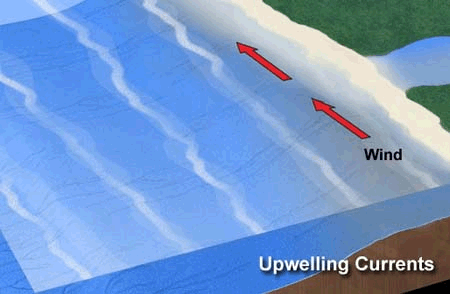
There are places in the ocean where water from the deep sea travels up to the surface. These are called areas of upwelling. The deep waters can have a large influence upon life in the ocean and the climate
...more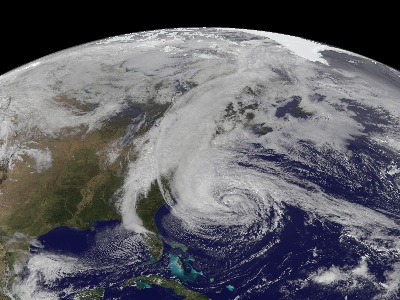
As a strong hurricane heads towards the coast, people prepare - boarding up houses, packing the car, and evacuating. These storms can spell disaster for people in hurricane prone areas, so they are taken
...more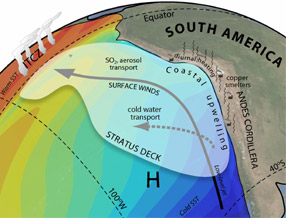
The winds in the Southeast Pacific mainly blow from south to north. They have a strong effect on the climate in the region and worldwide. The winds in this area get their start with a major flow in the
...more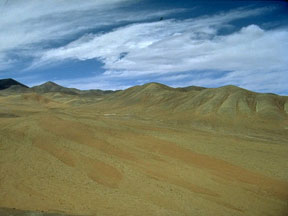
The Atacama Desert is one of the driest places on Earth. The Atacama is in the country of Chile in South America. In an average year, much of this desert gets less than 1 millimeter (0.04 inch) of rain!
...more


